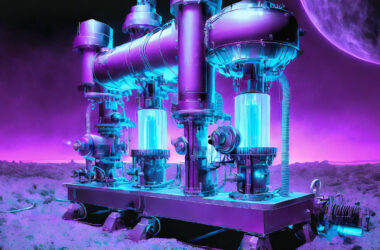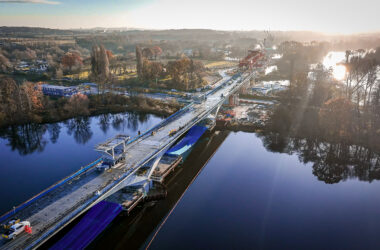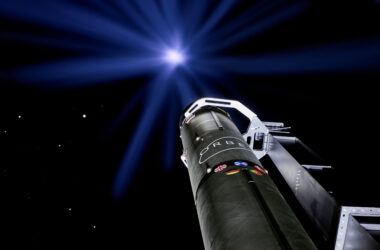The ambitious Bloodhound land speed racing project is gearing up for a renewed bid to break the 800mph barrier and set a new world land speed record.
Bloodhound first burst onto the scene in 2008, intending to break the 763mph record. After hitting financial and logistical hurdles, the British team is ready to mount another attempt – with some fundamental changes.
Central to rebooting their world record attempt is finding a new driver to replace Wing Commander Andy Green, the current record holder from his 1997 Thrust SSC run. While Green will continue as a mentor, Bloodhound’s owner seeks an individual with the skill to handle 500mph speeds and, critically, the funding to back the project.
Bloodhound estimates needing around £12 million ($14.6 million) to complete its mission. The recruit must have the aptitude Green demands – “a particular mind to sit in Bloodhound” but also bring the funding required to complete the effort.
This sponsor-driver model is standard in motorsports, but sceptics question whether someone with the required wealth will volunteer for such a dangerous role. All candidates will face rigorous scrutiny from Green, who will be heavily involved in selection and training. Marketing activities like a UK roadshow aim to lure prospective drivers with this “once-in-a-lifetime opportunity.”
Accompanying the hunt for a new driver is Bloodhound’s shift towards zero-emissions technology. This aligns with evolving sustainability priorities and helps make the project relevant again after years of delays. Bloodhound will now run its jet engine on specially formulated synthetic fuel, moving away from traditional fossil fuels. An electric pump will also replace the old fuel pump, significantly reducing emissions.
Technical director Stuart Edmondson believes these changes make Bloodhound pivotal in gathering data on sustainable aviation fuels. The Rolls-Royce EJ200 jet used in Bloodhound also powers military aircraft, which are unlikely to disappear soon. Validating synthetic fuels on Bloodhound’s ground tests could influence development across the aerospace industry.
Transitioning to green technology is more complex, however. The difficult task of formulating and delivering suitable synthetic fuel brings unpredictability. And relying more on electrics leaves less margin for error. But Edmondson sees the challenges as a necessary evolution, calling Bloodhound’s previous form “a fire-breathing machine of the old school.”
The other half of Bloodhound’s phenomenal power is a Nammo rocket designed to propel the car over 800mph. This motor runs on hydrogen peroxide, breaking into steam and oxygen when ignited. It produces no emissions except water vapour, aligning with the sustainability initiative. The rocket will fire sequentially after the jet engine accelerates Bloodhound to around 650mph.
This tandem configuration delivered a 628mph run on South Africa’s Hakskeen Pan in 2019, but mechanical issues prevented Bloodhound from engaging the rocket. For a record-breaking attempt of 800mph+, the jet-rocket partnership will need to fire flawlessly. Even minor tweaks can impact performance.
Bloodhound’s return to the Pan’s 12-mile track depends on clearing the financial and logistical hurdles. The converted mine site provides ideal topographical conditions, but its remote location in the Northern Cape presents transportation challenges. Reassembling the 13.4-tonne car and support equipment takes meticulous planning.
Edmondson estimates that if sufficient funding arrives, Bloodhound could be race-ready for high-speed trials in mid-2025. The team continues coordinating with local authorities to secure access.
Once operational, Bloodhound aims to best the 763mph record by at least 5% – an FIA Outright World Land Speed Record requirement. This means exceeding 800mph, a psychological barrier no car has ever crossed. The technical margin between 763 and 800mph is small, but the leap would secure Bloodhound’s place in history. It would also deliver invaluable data on high-speed land travel that could influence future transportation technologies.
Whether Bloodhound and its new driver/sponsor can achieve this feat remains to be determined. For Edmondson and the team, the allure of unprecedented speed on land – powered by an innovative green rocket – makes the challenge irresistible. If triumphant, Bloodhound will be a symbol of inspired engineering, boundary-pushing courage, and sustainable innovation.
If you think you have what it takes you can apply to drive now at bloodhoundlsr.com
- Bloodhound land speed racing car aiming to break 800mph barrier and set new world record
- Searching for new driver with funding to replace Andy Green, who will stay as mentor
- Switching to synthetic, zero-emission fuel for jet engine to be more sustainable
- Rocket runs on hydrogen peroxide, producing just water vapor and oxygen
- Targeting new record attempts on South Africa’s Hakskeen Pan track in 2025
- Breaking 800mph mark would be huge psychological milestone for land speed








